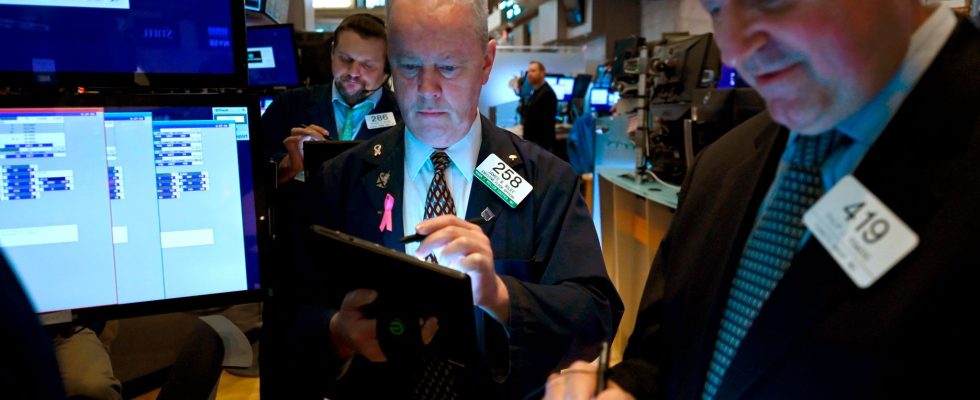The American economy is resisting. “If eighteen months of rising interest rates from the American central bank (Fed) were supposed to cool the world’s largest economy, consumers had another idea,” quips the Financial Times. While the country has just experienced an aggressive campaign to tighten its monetary policy, the disaster scenario will not occur: growth in economic activity doubled in the third quarter, driven by household consumption, a new snub to the recession promised for months.
Figures that come at the right time for Joe Biden, campaigning for his re-election. Growth in gross domestic product (GDP) in the United States stood at an annualized rate of 4.9% for the three months from July to September, according to the first estimate from the Commerce Department, published Thursday, October 26. This pace exceeds the 4 to 4.7% expected by analysts, according to several consensuses. “I never believed that we would need a recession to bring down inflation,” responded President Joe Biden in a press release.
Unsurprisingly, the Democrat, who hopes to be re-elected to the White House in 2024, attributed the merit of this solid growth to the measures introduced since his election: “It is a testimony to the resilience of American consumers and workers, supported by Bidenomics”, nickname given to his economic policy. Indeed, the president owes this good news to American households who continued to spend (computer equipment, travel, etc.), fueling the main engine of the economy. However, their wallets were already punctured by expenses for basic necessities: electricity, health care, medicines, financial services and insurance. But nothing to taint the optimism of the Americans.
Another green signal: household investments are also taking off, proof that households are not afraid of the future. Home purchases soared to more than 12% in September. A jump of 30% over one year, thanks to the numerous discounts offered by developers to compensate for borrowing rates which are closer to 8%.
“A soft landing”
Already in the second quarter, the expansion of the American economy had already surprised by its strength, at 2.1% at an annualized rate, and 0.5% compared to the previous quarter. A significant jump driven by the post-Covid recovery. Note that the United States favors growth at an annualized rate, that is to say the growth that would be achieved over the entire year at this rate. Other advanced economies simply compare each quarter to the previous one, which gives 1.2% for the United States in the 3rd quarter.
This is “explosive” growth, notes Kathy Bostjancic, chief economist at the Nationwide insurance company. Treasury Secretary Janet Yellen thinks the situation “looks like a soft landing, with very good results for the U.S. economy,” she said Thursday on Bloomberg. The famous “soft landing” is one that would slow inflation without causing the unemployment rate to soar, or plunging the economy into recession.
But will this dynamic last? “I do not expect growth to continue at this rate. But we have good solid growth”, and the 2023 GDP should be “close to 2.5%”, anticipates the Minister of the Economy by Joe Biden. Growth should continue in the fourth quarter, but at a “significantly” slowed pace, also forecasts Rubeela Farooqi, chief economist for High Frequency Economics, citing the “greater impact” of high rates, “on consumers and businesses at ‘future”. Moreover, the Americans have dipped into their savings. Their savings rate, which peaked at more than 30% in 2020, fell to just 3.8% in September, according to Fed data. Proof that consumption will not be able to maintain the pace.
A momentum that should not last
Inflation has been reducing the purchasing power of American households for two years. However, the Fed wants to voluntarily slow down growth, to ease the pressure on prices. It has in fact raised its rates 11 times since March 2022. They are now at their highest since 2001. The increase in interest rates has the effect of increasing the borrowing rate and slowing down purchases. Not enough so far, however, to stop the growth. Because Americans have jobs (336,000 net more positions in the third quarter, twice as expected), and therefore income.
But once again, the country is under the threat of a paralysis of the federal state, the “shutdown”, if the head of the House of Representatives, newly elected, Mike Johnson, does not manage to pass a budget for the federal administration. Inflation in September was 3.7% year-on-year, according to the CPI index published by the Labor Department. The PCE index, the Fed’s preferred barometer, will be released on Friday. In 2022, GDP growth in the United States had slowed to 2.1%, after experiencing its highest rate in 2021 since 1984 (5.9%). And 2020 saw the biggest decline in GDP since 1946 (-3.5%), with two months of recession due to Covid-19.
